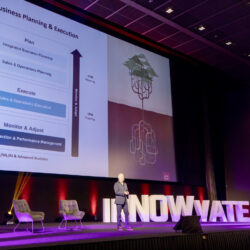Sales & Operations Planning: just jump in at the deep end

Despite significant efforts, sales and operations remain two completely different worlds within many companies. How can we bring them closer together? Richard Evans from Slimstock advocated a practical approach during a recent Webinar Wednesday. Instead of spending an unnecessary amount of time on fine-tuning the Sales & Operations Planning (S&OP) process, just jump in and get started with it. “No one learns to swim by standing at the side of the pool.”
By Marcel te Lindert
Richard Evans was sitting at the breakfast table with his family one morning when his 14-year-old daughter suddenly presented them with a list of ingredients that she needed in order to make spaghetti bolognese during a class at school later that day. “I looked in the fridge but it was empty, so you can imagine the frustration and stress. To cut a long story short: I jumped in the car to pick up minced meat and tomatoes from the nearest store – which definitely wasn’t the cheapest option,” recalled Slimstock’s Managing Director for the UK and Northern Europe.
Evans used the incident to draw a parallel between his family and a business, as if his daughter were the sales director and he were the operations director. “This is how it goes in many companies. People see a shortage, get stressed and react in panic. Even though my daughter only needed 200 grams of minced meat, I had to buy 500 grams because the local store didn’t have smaller packs. So I was stuck with 300 grams of meat, and I was also late for work!”
Speaking a different language
Evans continued to analyse the problem, which he said stemmed from the long delivery time of seven days – because his family does the grocery shopping for a whole week every weekend. “So when my daughter produced the list just two hours beforehand, that didn’t work. On top of that, my 14-year-old daughter isn’t a great communicator – but neither are many sales directors in real life. Their communication skills aren’t always the best. In fact, they often speak a completely different language. Salespeople talk in terms of euros and dollars, whereas for Operations it’s about units, litres or kilos.”
Companies implement S&OP to improve the alignment between Sales and Operations, which remains difficult. “They are two different worlds. Maybe there is some alignment at the highest level, but as you move lower down through the organization you soon see significant differences and conflicting interests. For example, Finance is keen to reduce the demand on working capital, whereas Sales wants to sell everything listed in the catalogue. You can’t do both.”
Supply chain as an amplifier
The lack of alignment might not be such a problem in a stable and harmonious world – but the world hasn’t been like that for several years now. “We live in chaotic times. We have to deal with volatility and variable delivery times. And then we have the events that no one could predict, such as the pandemic, the current inflation and the situation in Ukraine. Without proper alignment and without transparency, the supply chain acts as an amplifier, creating bullwhip effects.”
Alignment requires three conditions to be met. Firstly, it is important to set common goals. Secondly, it is necessary to provide people with the right information at the right time so that they are able to make the right decisions. “Lastly, it’s important to continuously improve. You can only do that by getting started and learning from your mistakes. It’s just like at the swimming pool. Nobody ever learned to swim by standing on the side.”
Don’t forget about product management
Evans described S&OP as a process that brings together people from different departments: from Sales to provide insight into demand, from Operations to provide insight into available capacity, and from Finance to translate it all into financial performance. “Product Management is often forgotten in this process. But the process of phasing products in and out will continue to become increasingly important. New products are becoming popular or unpopular faster than ever.”
In Evans’ view, the evolution of supply chain planning does not stop at S&OP; the next step is Integrated Business Planning (IBP), followed by end-to-end supply chain planning. “This is all about collaboration. Ask yourself the question: are you an A, B or C-category customer for your supplier? If you are an A-category customer, then start sharing information with that supplier. You are an important customer to them; they want to listen to you and work with you. You should collaborate with them in the same way as you do with your own factories, yet we often think of them as the enemy.”
Strategic objectives
One issue that many companies struggle with involves strategic objectives that are set by the board. Which steps do you need to take to achieve them? “The basis is formed by the company’s organic growth: the growth we will achieve if we continue to do what we’ve been doing. But the board also has some ambitions: to enter a new market, for example, or to introduce a new product group. The question is, how can you move closer to fulfilling those ambitions? The answer is to translate the ambitions into tangible tasks in order to bring success a step closer.”
Slimstock has expanded its supply chain software to include an S&OP layer in which projects can be defined in line with the strategic goals. Senior executives can monitor the progress at a glance. “It’s easy for current users of our software to take advantage of this. It’s simply a matter of plugging this S&OP layer into the existing platform,” said Evans. He concluded by returning to the topic of spaghetti bolognese: “Maybe I shouldn’t have gone to all that trouble to pick up those groceries. It’s clear that my daughter will never become a chef!”










